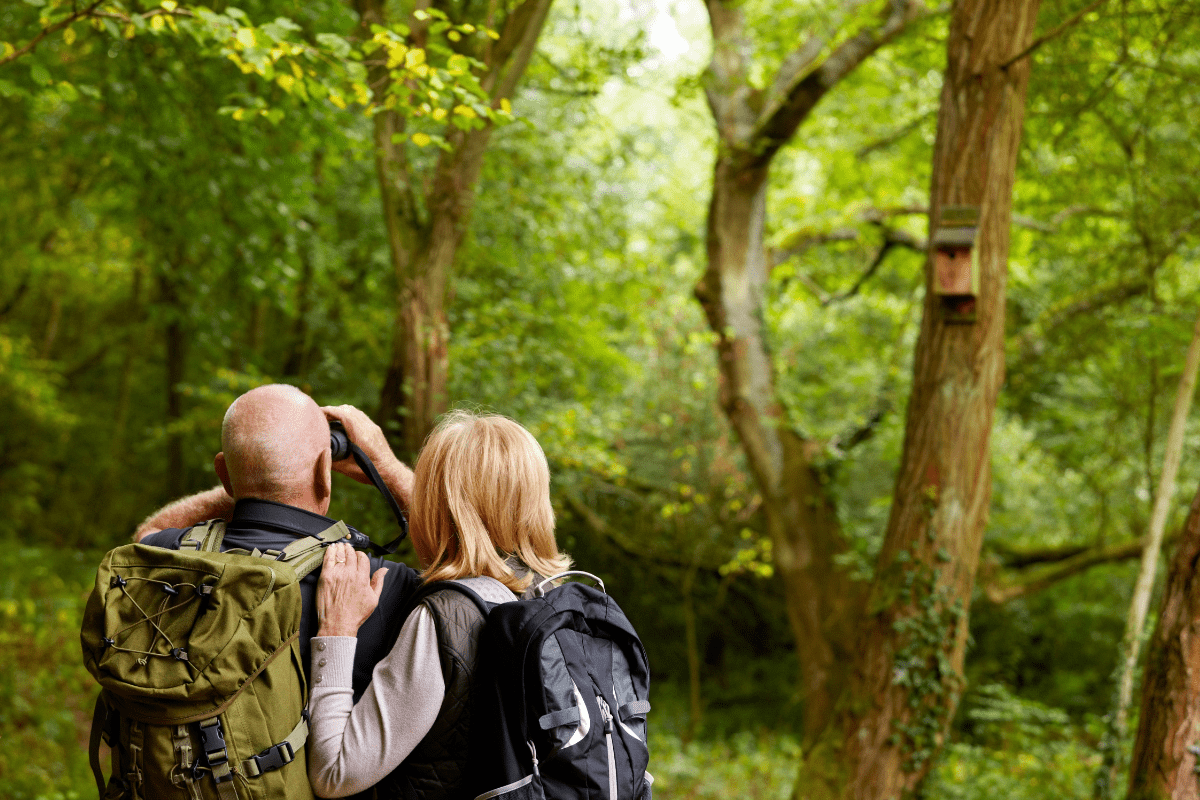Let's be honest: Oregon has always marched to the beat of its own drum. From a 26-foot rabbit holding a coffee cup to the world's largest pig hairball in a monastery, this state takes "keeping it weird" seriously. With over 300 documented roadside attractions contributing to Oregon's $13.9 billion tourism industry, these quirky stops have become essential threads in the state's cultural fabric.
The heavy hitters you can't miss
Every Oregon road trip needs a few guaranteed crowd-pleasers, and these attractions deliver the perfect mix of weird, wonderful, and "wait, what?"
Portland's doughnut dynasty
Nothing says "Welcome to Oregon" quite like waiting in line at 2 AM for a bacon-covered doughnut. Voodoo Doughnut has somehow transformed fried dough into Portland's unofficial ambassador since opening in 2003. The original location at 22 SW 3rd Avenue stays open until 3 AM because apparently normal business hours are for normal businesses.
Their menu reads like a sugar-fueled fever dream. The Bacon Maple Bar? Classic. The Voodoo Doll filled with raspberry jelly and stabbed with a pretzel? Slightly concerning but delicious. In 2008, Portland even designated their Portland Crème as the "Official City Doughnut," which tells you everything about this city's priorities.
Pro tip: The line moves faster than you think, and yes, it's worth the wait. Just embrace the tourist trap… it's a really tasty tourist trap.
Where physics goes to die
Down in Gold Hill, the Oregon Vortex has been confusing visitors since 1930, making it America's first documented "mystery spot." Within this 165-foot circle of weirdness, balls roll uphill, people change height, and brooms stand at impossible angles. Native Americans supposedly called it "Forbidden Ground" where horses refused to enter, which should have been everyone's first clue.
The whole thing started when a mining assay office from 1904 slid off its foundation during a 1910 landslide. Instead of fixing it, someone said "Hey, let's charge admission!" The 45-minute tours cost $16-22 for adults, and honestly, watching your brain try to process what your eyes are seeing is worth every penny.
Is it real? Is it an optical illusion? Who cares… it's been baffling people for almost a century, and that's good enough for me.
Jurassic Park, Oregon style
Near Port Orford, Prehistoric Gardens proves that sometimes the best attractions come from one person's obsession. E.V. "Ernie" Nelson started building life-size concrete dinosaurs in 1955, researching each one at natural history museums for accuracy. The result? Twenty-three dinosaurs lurking in an actual temperate rainforest with 300-year-old trees.
The Discovery Channel has filmed here, which makes sense because where else can you find a scientifically accurate T-Rex surrounded by giant ferns? The same family still owns it, maintaining Ernie's vision of educational entertainment. It's like someone's backyard project got wildly out of hand in the best possible way.
Coastal attractions that actually deliver
Oregon's 362-mile coastline offers more than just pretty views. These attractions blend natural drama with human creativity.
The most photogenic shipwreck ever
The Peter Iredale shipwreck at Fort Stevens State Park might be the only tourist attraction that's literally falling apart. This four-masted steel sailing ship ran aground in 1906, and instead of cleaning it up, Oregon said "Nah, let's keep it."
All 27 crew members survived, which means we can enjoy the rusty remains guilt-free. Over 100 years of waves and weather have created a skeletal iron sculpture that looks absolutely incredible during storm season. Low tide lets you walk right up to it, making it the most accessible shipwreck on the West Coast.
America's noisiest cave
Sea Lion Caves near Florence takes the concept of a zoo and flips it. Here, you're the one in the enclosed space while hundreds of Steller sea lions lounge in America's largest sea cave. Discovered in 1880 by Captain William Cox, this natural amphitheater features a two-acre floor and 125-foot dome.
The elevator drops you 208 feet to viewing platforms where the real show begins. Winter offers the best viewing when rough seas drive the sea lions inside. At $18 for adults, it's pricey, but where else can you experience nature's version of a heavy metal concert? These massive pinnipeds don't believe in inside voices.
Trash turned treasure
The Washed Ashore project in Bandon transforms depressing ocean pollution into stunning art. Since 2010, artist Angela Haseltine Pozzi has created over 66 giant sculptures from 17 tons of beach garbage. Imagine walking around town and suddenly encountering Cosmo the Puffin at Coquille Point or Belle the Jellyfish in Coos Bay, all made from discarded flip-flops and water bottles.
It's environmental activism that doesn't lecture. Instead, these colorful creatures make you think "Wow, that's beautiful" followed immediately by "Oh wait, that's all trash." Genius.
The tree that forgot how to tree
At Cape Meares State Scenic Viewpoint, the Octopus Tree challenges everything you thought you knew about trees. This 250-300 year old Sitka spruce has no central trunk. Instead, six massive limbs extend horizontally up to 30 feet before remembering they're supposed to grow up.
Theories range from Native American ceremonial shaping to natural genetic mutations. Whatever the cause, this Oregon Heritage Tree looks like something Dr. Seuss would draw after too much coffee.
Portland keeps it weird (obviously)
Oregon's largest city packs more quirks per square mile than anywhere else in the state.
The 31-foot Paul Bunyan statue in Kenton has watched over North Portland since 1959. Built for the Oregon Centennial, this fiberglass lumberjack earned a spot on the National Register of Historic Places in 2009. He got a fresh paint job in 2024, because even giant lumberjacks need makeovers.
Powell's City of Books occupies an entire city block with 68,000 square feet of books. With over a million new and used books in 3,500 sections, it's less bookstore and more literary maze. They're open 365 days a year because Portland takes reading very seriously.
Downtown hosts Mill Ends Park, which held the Guinness World Record for world's smallest park until Japan stole the title. This 452-square-inch traffic median features one tree and originated when columnist Dick Fagan claimed the unused light pole spot for his leprechaun friend Patrick O'Toole in 1948. Only in Portland would this make perfect sense.
For something spookier, hike to the Witch's Castle in Forest Park. This abandoned 1930s stone structure sits where Oregon Territory's first legal hanging occurred in 1859. Social media has made it Instagram-famous, which means you'll probably share the ruins with aspiring influencers. The ghosts are used to it by now.
Eastern Oregon's wide-open weirdness
Out where cell service goes to die, Eastern Oregon offers attractions that match the landscape's scale.
Nature's art gallery
The Painted Hills unit of John Day Fossil Beds looks like Mother Nature went wild with watercolors. These striped hills formed from volcanic ash deposits over millions of years. Red bands show humid ancient periods, while black layers indicate organic matter from prehistoric floodplains.
Part of Oregon's official 7 Wonders, these 3,132 acres contain fossils of ancient rhinos, horses, and camels from when Oregon had a vastly different climate. Visit in late afternoon for the best light, or April-May for wildflowers. Fair warning: the clay becomes treacherously slippery when wet, turning hiking into unintentional slip-and-slide adventures.
Ghost towns and shoe trees
Eastern Oregon preserves the Old West in various states of photogenic decay:
- Shaniko: Former "Wool Capital" now has 30 residents
- Sumpter: Features gold dredge and weekend train rides
- Hardman: Authentic abandonment with minimal tourists
- Granite: True ghost town atmosphere
Along remote highways, you'll find shoe trees… because apparently regular trees are too mainstream. The Mitchell Shoe Tree on Highway 26 started this tradition, now sporting hundreds of shoes and a sign calling them "a bunch of old souls hanging around." Similar trees near Redmond, Tumalo, and Juntura prove Oregonians will decorate anything.
Willamette Valley's family-friendly oddities
Between Portland and Eugene, the valley offers attractions perfect for all ages.
Enchanted Forest near Salem represents Oregon's DIY spirit perfectly. Roger Tofte started hand-building this fairy tale theme park in 1964, opening it in 1971. Still family-owned, it features concrete storybook characters, underground tunnels, and homemade rides set in actual forest. The 2025 season runs March 22 through September 28, with advance online tickets offering the best prices.
For something completely different, Mount Angel Abbey Museum houses the world's largest pig hairball. This 37-pound mass came from an 1875 pig, proving monks have interesting ideas about museum-worthy artifacts. Call ahead for hours… monastery schedules can be unpredictable.
Southern Oregon embraces the strange
The state's southern region offers attractions that blur the line between geology and imagination.
Oregon Caves National Monument contains the nation's only underground Wild and Scenic River. Discovered in 1874 when Elijah Davidson's dog Bruno chased something into the darkness, these "Marble Halls of Oregon" feature 15,000 feet of passages. The constant 41°F temperature makes warm clothes essential for tours running March through November.
Near Applegate Lake, hiking three-quarters of a mile leads to the world's only Bigfoot trap. Built in 1974 by the North American Wildlife Research Organization, this 10-foot wooden cage caught only bears during its six operational years. It now stands as a monument to optimism and Pacific Northwest cryptid culture.
Planning your quirky Oregon road trip
Ready to experience Oregon's weird side? Here's how to make it happen.
Essential road trip wisdom
Coast trips along Highway 101 need 7-10 days to properly appreciate major attractions. Summer brings perfect weather and massive crowds, while winter offers dramatic storm watching and better sea lion viewing. Eastern Oregon requires different preparation entirely. Gas stations sit an hour or more apart, cell coverage remains spotty, and temperature extremes demand serious sun protection and water supplies.
What to pack for maximum weirdness
Your Oregon oddity expedition needs:
- Layers for rapidly changing coastal weather
- Waterproof jacket (it's Oregon, after all)
- Comfortable walking shoes
- Camera with extra batteries
- Cash for smaller attractions
- Sense of humor
State park day-use fees typically run $5-7, while paid attractions average $10-20 per person. Book summer lodging early, especially on the coast. Many rural attractions sit on primitive forest roads requiring high-clearance vehicles. GPS gets confused in remote areas, so print actual maps like it's 1999.
Photography tips for attraction hunters
Painted Hills photograph best in late afternoon light. Ghost towns shine during golden hour when shadows add drama. Bring flash equipment for cave interiors. The Peter Iredale shipwreck looks most dramatic during winter storms, though getting sandblasted while photographing might test your dedication.
Why Oregon's roadside attractions matter
These 300-plus oddities do more than entertain tourists. They preserve local history, support rural economies, and embody Oregon's fiercely independent spirit. Social media has sparked renewed interest, with Instagram and TikTok introducing new generations to attractions their grandparents visited.
Oregon's roadside attractions prove that the best travel experiences often come from embracing the absurd. Whether you're posing with dinosaurs in a rainforest, watching sea lions in their cave mansion, or trying to understand why someone hung shoes on a tree, these attractions remind us that weird is wonderful.
So grab some bacon doughnuts, fill up the gas tank, and hit the road. Oregon's quirkiest attractions are waiting, and they're even stranger than you imagined. Trust me… in a state where monks display pig hairballs and trees grow sideways, normal is definitely not the goal.




